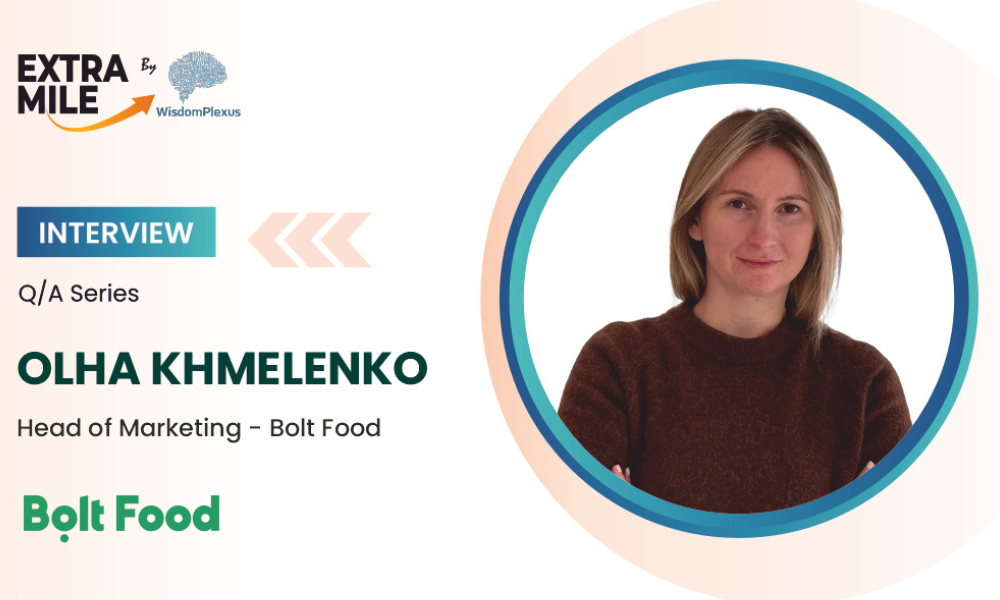ExtraMile by WisdomPlexus is an insightful interview series that aims to deliver knowledge and expert insights on the latest innovations to tech practitioners and enthusiasts.
In today's session, we are super excited to feature Olha Khmelenko, the Head of Marketing at Bolt Food. As a sub-segment of Bolt, the global shared mobility platform, Bolt Food focuses on food delivery services across Europe and Africa. The firm incorporates over 40,000 restaurant partners and third-party stores to deliver food and groceries.
As the Head of Marketing at Bolt Food, Khmelenko aims to adopt agile marketing approaches to stay adaptive in the competitive market. She focuses on delivering outstanding consumer experiences, ensuring enhanced product quality, and fair courier compensation.
Indulge in Khmelenko's journey in the marketing domain, alongside understanding how Bolt Food is delivering the best to its audience.
Hello, Olha; it's great to host you!
1. With more than 10 years of experience in digital marketing, what are the most significant milestones that have defined your career path? Given Bolt Food's impressive expansion to over 150 cities across 16 countries since 2019, how has your background prepared you to lead marketing during such rapid growth?
Over the past 10 years, I’ve worked across a range of regions and business models — from early-stage startups to large-scale marketplaces. One experience that really shaped my approach was helping scale startups from the ground up. We had to build everything from scratch, often with limited resources, and figure out how to grow sustainably — from early stages through break-even and beyond. That experience taught me to stay pragmatic, move quickly, and focus on what actually drives impact.
Another key part is leading marketing in highly data-driven environments, where decisions are based on impact, measurable outcomes, and rapid feedback loops.
2. Bolt Food has seen a remarkable expansion in different corners of the world quickly after its initial launch. What have been the most effective marketing strategies and what unexpected challenges did your team need to overcome during this growth period?
Over the past year, we took a close look at our expansion framework to better understand what was working and where we could improve. Rather than treating the framework as fixed, we adopted a more agile approach — continuously refining it after each launch. We incorporated real-time insights and feedback from individual markets, allowing us to adapt and scale more effectively across diverse regions.
We also found that while our launch framework was strong, there was often a drop-off once a city transitioned into BAU (Business As Usual). To address this, we re-evaluated how long we treat new cities as 'launch-phase' markets and built a structured framework to define ongoing support needs, budgeting logic, and the resources required post-launch.
When it comes to channel mix, a key advantage for us is our existing presence through Bolt’s ride-hailing platform. This allowed us to tap into a large, established user base and drive adoption of Bolt Food at a much lower cost. By using targeted, highly relevant offers, we significantly improved engagement and conversion rates across new markets.
3. As a three-sided marketplace linking restaurants, delivery couriers, and consumers, how do you balance the needs of these various stakeholders in your marketing strategy? What are the most challenging conflicts that arise between these groups, and how does your marketing approach help resolve them?
Balancing the needs of different stakeholders starts with alignment at the business level — something our Business Operations team manages exceptionally well. Instead of competing for resources, our teams work in a complementary way, united around a shared priority: delivering an outstanding consumer experience while ensuring restaurants maintain healthy margins and couriers are fairly compensated.
One way we manage this balance is through our centralized Marketing Calendar. Before launching consumer promotions, we proactively engage with restaurants to align on participation and cost-sharing. This gives them time to prepare operationally, and it enables us to deliver strong value to consumers through competitive pricing and great selection. We're also launching a new tool in July that will give restaurants and stores full visibility into upcoming campaigns and allow them to opt in directly — improving both transparency and participation.
For couriers, we focus on clear communication around campaign impact. When they understand that promotions can drive higher order volume — and, in turn, increase their earnings — they're more likely to stay active during peak periods. We also run targeted incentives to ensure we have the right coverage to meet elevated demand.
4. How does Bolt Food use marketing to differentiate itself and be unique from incumbent players in this segment? Could you share examples of specific campaigns, partnerships, or marketing initiatives that have been particularly effective in establishing Bolt Food's unique position in the market?
We’ve built our brand promise around affordability, making value a central theme across our campaigns and customer experience. Campaigns like “Wallet-Friendly Deals,” “Valentine’s Day Specials,” and “New Year, Same Me” are great examples of driving engagement by aligning strong offers with seasonal moments of high demand.
These initiatives are part of our co-investment model, where restaurant partners co-fund special deals. We then amplify these offers through a 360° marketing strategy that includes in-app banners, push notifications, social media, influencer partnerships, outdoor advertising, and cross-promotion in the Bolt Rider app — ensuring high visibility and driving user engagement.
5. Bolt Food covers both food and grocery delivery. What are the challenges and opportunities of marketing these separate services under the same brand name? How do you determine the allocation of marketing resources between these services, and has this balance shifted over time?
Resource allocation has naturally evolved over time. Initially, food delivery was the primary focus, as it had broader adoption and more established user behavior. But as grocery delivery has gained traction, especially in select markets, we've adjusted both budget and strategy. Today, we take a more balanced approach, driven by market-specific data on adoption, frequency, and user lifetime value.
From a marketing perspective, we’ve leaned into more tailored campaigns and performance tracking across verticals — ensuring we speak to the right intent, at the right time, with a message that resonates based on the user’s context.
We're also exploring opportunities to expand the platform beyond groceries, enabling users to order a wider range of products such as flowers, books, and cosmetics for delivery.
6. Customer feedback is imperative in enhancing service quality. How does Bolt Food incorporate user feedback into its marketing strategies? Which feedback channels (app reviews, social media, surveys, etc.) have proven most valuable?
We collect feedback through different channels: app reviews, social media, surveys, and direct conversations with users.
One of my favorite projects at Bolt is called "Call Your Customer." For about three-month cycles, product managers, designers, and marketing managers have short weekly calls with real users to understand what people really need. Our ResearchOps team helps with finding users, preparing questions, and collecting feedback. After the calls, the team shares key insights, which are used to improve our product, user experience, and marketing campaigns. This way, our decisions are based on what users actually say, not just our own assumptions.
It's an industry standard, but it's quite important not to miss mentioning that we prompt instant feedback after each delivery, which provides a satisfaction score for every merchant. This continuous stream of data helps us identify areas for improvement in real time and maintain high service standards.
We also run "Day as a Courier" or "Day in a Restaurant" activities, where team members spend time in the field to see how our partners and couriers work.
7. Looking at the broader digital marketing landscape, what technology or trends will have the most impact on food delivery marketing in the next few years? How is Bolt Food preparing for these developments?
Personalization and automation will continue to reshape how we approach marketing. With better access to real-time user data, there’s a growing opportunity to deliver highly relevant messages — from the right dish recommendation to the perfect time to re-engage — without overwhelming users. AI and machine learning will play a bigger role here, both in optimizing campaigns and in shaping the customer journey.
Another key trend is the growing emphasis on privacy and first-party data. As platforms tighten access to third-party data, building direct relationships with customers and collecting meaningful, consent-based insights becomes more important. This shift is already informing how we think about retention and loyalty strategies.
8. Finally, what would you advise marketing professionals looking to thrive in the fast-evolving food tech industry, specifically those working with marketplace business models?
I’d say stay adaptable. The environment changes quickly, so a commitment to ongoing learning and experimentation is key.
In my experience, the most effective marketers are those who can balance creative thinking with strong analytical skills.
And it’s obvious, but it's really important — collaboration across teams is fundamental. Working closely with product, operations, and data teams allows marketing to be more strategic and aligned, which ultimately drives better outcomes across the business.
Dive Into Another Expert Conversation:


